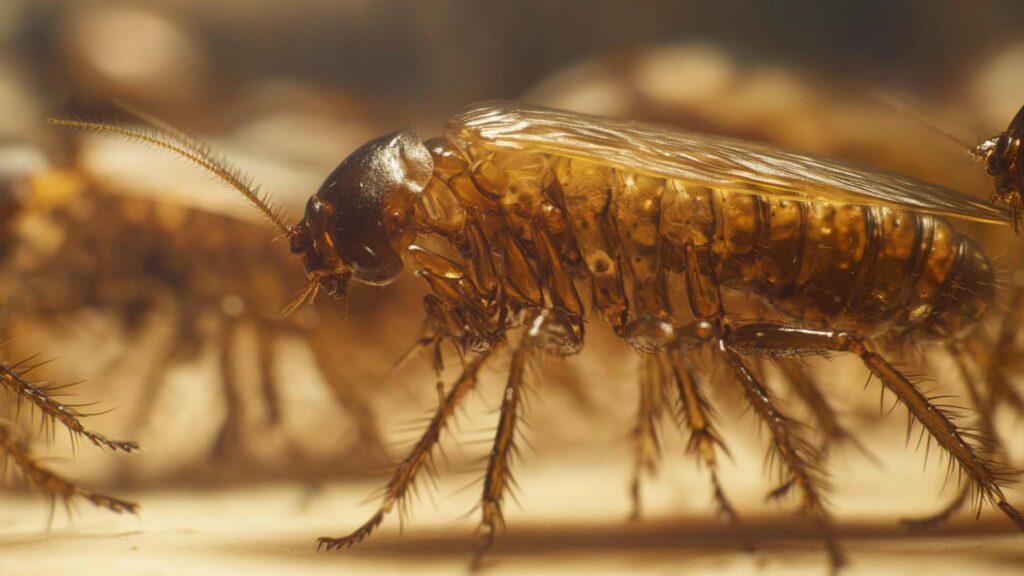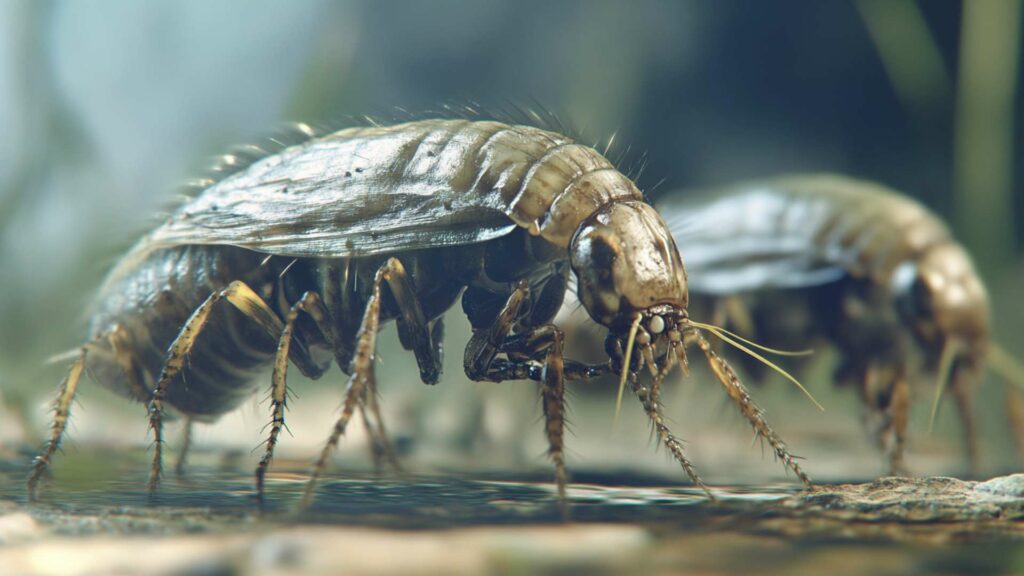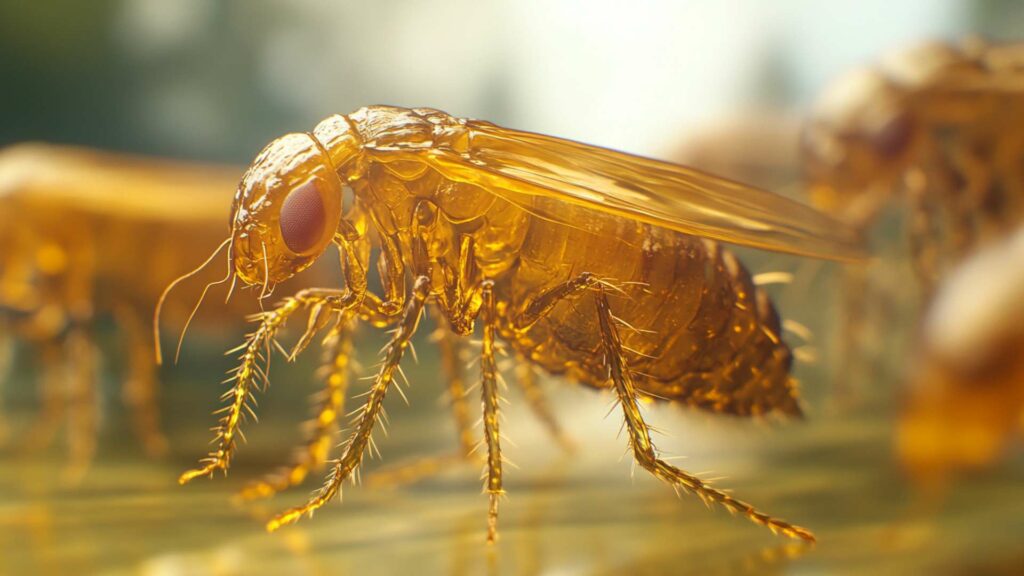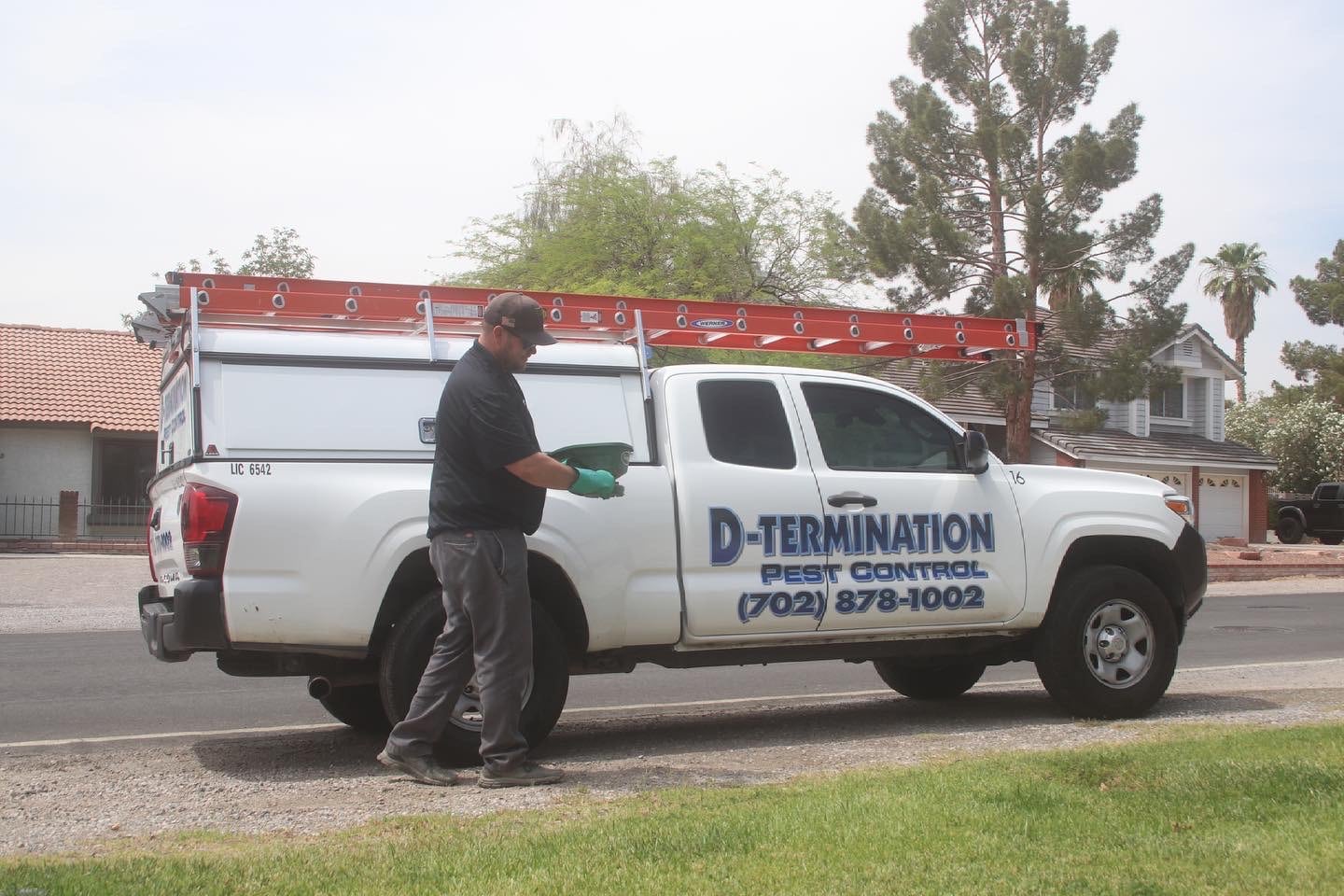Diatomaceous earth, often referred to as DE, is a naturally occurring sedimentary rock made up of the fossilized remains of tiny aquatic organisms called diatoms. These microscopic creatures have hard shells made of silica, which is a form of silicon dioxide. Over millions of years, these diatoms settled at the bottom of bodies of water and formed deposits that eventually became what we now know as diatomaceous earth.
The composition of diatomaceous earth is quite fascinating. Under a microscope, it appears as a fine powdery substance consisting of countless sharp-edged particles.
These particles are what make DE such an effective tool in combatting various pests like fleas. The sharp edges act like miniature shards, puncturing the exoskeletons or outer coverings of insects and causing them to dehydrate and die.
Overview of its Natural Origin and Formation

The natural origin and formation process of diatomaceous earth go back thousands or even millions of years. It all starts with the life cycle of diatoms in bodies of water such as lakes, rivers, or oceans. These single-celled organisms produce shells composed mainly of silica extracted from water sources they inhabit.
Over time, when these diatoms die and sink to the bottom, their shells accumulate layer upon layer. As this process repeats over thousands or millions of years without disturbance or erosion, thick deposits form.
Geological processes like tectonic movements can raise these deposits to land surfaces where we find them today. Once discovered by humans for its remarkable properties, such as its abrasive nature and high silica content, diatomaceous earth has found numerous applications outside pest control too—ranging from filtration aids in liquids to soil amendments in agriculture.
Understanding the composition and natural origin sets the stage for exploring how diatomaceous earth works effectively as a natural flea control method. In the following sections, we will dive deeper into its mechanism of action and learn practical tips on its application for successful flea eradication.
Understanding Fleas and Their Impact
Brief Explanation of Flea Life Cycle and Behavior
Fleas, those tiny, pesky creatures that make our beloved pets scratch incessantly, have a life cycle consisting of four stages: egg, larva, pupa, and adult. Understanding this cycle is crucial in effectively combatting these unwelcome intruders.
It all begins when female fleas lay eggs on their furry hosts or in the surrounding environment. These eggs are incredibly small and can be found anywhere your pet frequents – from their cozy pet beds to the corners of your living room carpet.
Within a few days, these eggs hatch into larvae that are blind but extremely active. They feed on organic matter such as flea feces and other debris from dead fleas.
After going through several molts, the flea larvae spin a cocoon and enter the pupal stage where they undergo metamorphosis into adults. The last stage is when adult fleas emerge from their cocoons fully developed and ravenous for blood.
They jump onto unsuspecting hosts (often our pets) to feed within seconds of sensing their presence. Once they find a suitable host, they mate and begin laying eggs to continue the vicious cycle.
Discussion on the Health Risks Associated with Fleas

Fleas aren’t just an annoyance; they pose health risks not only to our furry friends but also to us humans living under the same roof. These minuscule parasites can transmit various diseases such as tapeworms, bartonellosis (cat-scratch fever), typhus, and even bubonic plague (though rare). Additionally, flea bites can cause intense itching and discomfort for both pets and people alike.
For our beloved pets specifically, fleas can lead to allergic reactions known as flea allergy dermatitis (FAD). This condition causes severe itching, hair loss, and skin problems in sensitive individuals.
Fleas also thrive on blood meals, potentially causing anemia in young or weakened animals if left untreated. To prevent these health risks and keep our homes free from a major infestation remove fleas, it’s crucial to take proactive measures against fleas.
One effective method is to use diatomaceous earth for flea control—a natural and safe alternative to harsh chemicals that can harm our pets or loved ones. By understanding how diatomaceous earth works and following proper application techniques, we can successfully get rid of fleas without compromising our well-being.
How Diatomaceous Earth Works for Flea Control
Explanation of diatomaceous earth’s physical properties

Diatomaceous earth, commonly referred to as DE, is a versatile natural substance, that works wonders in flea control. It is composed of the fossilized remains of tiny aquatic organisms called diatoms.
These diatoms create intricate silica structures, giving DE its unique properties. The microscopic structure of DE consists of sharp edges that are harmless to humans and pets, but deadly to fleas and other insects.
Microscopic structure and sharp edges
The sharp edges present in diatomaceous earth particles act like shards of glass when insects come into contact with them. When fleas or other insects crawl through areas treated with DE powder, the jagged edges lacerate their exoskeletons. This damage leads to severe dehydration due to moisture loss, ultimately resulting in their demise.
Absorbent nature and ability to dehydrate insects
One of the key reasons why diatomaceous earth works so effectively against fleas is its absorbent nature. DE has a remarkable ability to draw moisture from the bodies of fleas and other pests upon direct contact.
Once it comes into contact with a flea or insect’s exoskeleton, however, the powdery texture absorbs oils and fats from their body’s protective layer, causing them to dry out rapidly. Detailed description of how it affects fleas at different stages of their life cycle
Fleas go through four stages in their life cycle: egg, larva, pupa, and adult. An important aspect of using diatomaceous earth for flea control is that it can be effective at flea reproduction at any stage.
When applied correctly around your home or on your pet’s skin, DE powder can target flea eggs by puncturing their protective shells upon contact. Furthermore, when larvae come into contact with applied diatomaceous earth alone, the sharp edges of the powder penetrate their soft bodies, causing significant dehydration.
This disrupts their development and reduces the chances of them reaching adulthood. Even if fleas manage to advance to the pupal stage, DE can still be effective.
Once adult fleas emerge from their cocoons and come into contact with DE particles, they will suffer the same fate as others – dehydration and demise. Using diatomaceous earth for flea control is a natural form of pest management that offers an environmentally friendly solution to flea populations.
However, it’s crucial to use food-grade DE powder to ensure safety for your pets and family members. Remember to avoid breathing in excessive amounts of DE dust during other diatomaceous earth applications and always follow proper diatomaceous earth application guidelines to effectively get rid of fleas without causing harm or discomfort to anyone involved.
Choosing the Right Type of Diatomaceous Earth for Flea Control
Differentiating between Food-Grade and Non-Food-Grade Diatomaceous Earth
When it comes to choosing the right diatomaceous earth (DE) for flea control, it’s important to understand the distinction between food-grade and non-food-grade options. Food-grade DE is specifically processed and purified for human consumption, making it a safer choice for households with pets.
This type of DE is more finely ground, which allows for easier application on pets’ bedding areas without causing irritation. On the other hand, non-food-grade diatomaceous earth is primarily used in industrial applications such as pool filtration systems or pest control.
While non-food-grade DE can still be effective against fleas, it’s important to exercise caution when using it around pets or in outdoor environments. This type of DE may have coarser particles that can potentially irritate their skin or cause discomfort if ingested.
Benefits and Limitations of Food-Grade DE for Pet Owners
Food-grade diatomaceous earth offers several benefits for pet owners seeking a natural solution to control fleas. Firstly, this type of DE is generally considered safe for direct contact with pets’ fur and skin.
When applied correctly, food-grade DE acts as an effective flea preventative by dehydrating adult fleas on contact. Additionally, since food-grade DE goes through a purification process to remove impurities like crystalline silica, it poses a lower risk of respiratory irritation compared to non-food-grade alternatives.
However, despite its advantages, there are some limitations to keep in mind when using food-grade diatomaceous earth for flea control. One key consideration is that DE works best when kept dry; moisture reduces its effectiveness against fleas.
Therefore, if you live in a humid environment or your pet frequently gets wet (e.g., swimming), reapplication may be necessary. It’s also important to note that while food-grade DE is safe for pets, it should always be used with caution around their eyes, nose, and mouth to prevent irritation.
Considerations when Using Non-Food-Grade DE in Outdoor Environments
Using non-food-grade diatomaceous earth kills fleas when outdoors requires additional considerations due to its coarser texture and potential impurities. When using this type of DE for flea control in outdoor environments like yards or gardens, it is crucial to select a filter-grade diatomaceous earth rather than a pool-grade variant. Filter-grade diatomaceous earth has undergone further processing to remove harmful substances like high levels of crystalline silica, making it safer for contact with pets and humans.
When applying non-food-grade DE outdoors, focus on targeting areas where fleas thrive, such as shaded spots or moist areas. Dust or spray the diatomaceous earth evenly across the infested areas using protective gear like gloves and a mask.
Avoid excessive application near plants or water sources to minimize potential ecological impact. While non-food-grade DE can be effective against fleas outdoors, keep in mind that prolonged exposure may still cause respiratory irritation, so it’s advisable to limit direct contact between pets and treated surfaces.
If you have hardwood floors indoors that require flea control treatment using non-food-grade DE, consider applying the product strategically while minimizing pet access until thoroughly cleaned up using methods like vacuuming with a shop vac. Remember, regardless of the type of diatomaceous earth you choose for flea control—food—grade or non-food-grade-always read the instructions carefully and take appropriate safety precautions to ensure the well-being of both your pets and yourself.
Application Methods for Effective Flea Control with Diatomaceous Earth
Step-by-Step Instructions for Indoor Application
When it comes to indoor flea control using diatomaceous earth (DE), a thorough approach is necessary to ensure the best results. Start by treating carpets, rugs, and upholstery, as these are common hiding places for fleas. Sprinkle a generous amount of DE throughout the affected areas, focusing on areas where your pet spends most of their time.
Use a brush or broom to work the powder deep into the fibers. Leave it overnight or preferably for 24 hours before vacuuming up any excess powder.
Next, pay attention to your pet’s bedding areas. Remove all bedding and wash it in hot water before sprinkling DE over the freshly cleaned and dried bedding.
Ensure an even distribution and let it sit for a few hours before returning the bedding to its place. Safety is paramount when using diatomaceous earth around pets and children.
Although non-toxic, DE can be drying and irritating if directly inhaled in large amounts or if it enters the eyes or mucous membranes. It’s advisable to keep pets separate from treated areas during application and until you’ve thoroughly cleaned up any excess powder.
Tips for Outdoor Application in Yards or Gardens

Taking your flea control efforts outdoors can effectively prevent reinfestation from outside sources. Start by targeting shaded spots and moist areas where fleas tend to thrive, such as under bushes, decks, or around outdoor furniture. For even distribution in outdoor environments, consider using a garden sprayer filled with diatomaceous earth/water mixture (follow product instructions).
Spray this mixture evenly on affected surfaces like patios, grassy areas, and soil patches near entrances/exits where pets frequent. Alternatively, you can dust DE directly onto those areas using a handheld duster or spreader.
Remember to reapply DE after rain or heavy water exposure, as it may lose its effectiveness. By consistently treating outdoor areas where fleas are likely to reside, you can create a more comprehensive barrier against flea infestations.
Additional Considerations for Successful Flea Control with Diatomaceous Earth
Importance of Consistency in Reapplication Intervals
To achieve optimal results in flea control, it’s crucial to adhere to reapplication intervals. Adult fleas can lay hundreds of eggs daily, and the life cycle of fleas includes egg, larva, pupa, and adult stages. By reapplying diatomaceous earth for fleas every 7-10 days for several weeks or until the infestation subsides completely, you can effectively target newly hatched larvae and prevent them from reaching adulthood.
Combining DE Treatment with Other Methods
While diatomaceous earth is an effective natural form of flea control on its own, combining it with other preventive measures can yield even better results. Regularly bathing pets with non-toxic flea shampoos or using a flea comb to remove adult fleas and their eggs from your pet’s fur are important complementary approaches.
Additionally, maintaining good hygiene by washing pet bedding frequently and vacuuming carpets regularly helps eliminate any remaining fleas or eggs that may have escaped the DE treatment. By implementing a holistic approach that combines various methods in conjunction with diatomaceous earth application, you’ll have a stronger defense against flea infestations.
Conclusion
Incorporating the use of diatomaceous earth as part of your natural flea prevention and control regimen provides a safe and effective solution for combating these pesky critters. Its non-toxic nature makes it ideal for homes with pets and children who may be more susceptible to health concerns associated with chemical treatments.
By following step-by-step instructions for indoor application, targeting key areas where fleas thrive both indoors and outdoors, and maintaining consistency in reapplication intervals, you can successfully utilize diatomaceous earth to alleviate flea issues. Remember to combine DE treatment with other preventive measures for comprehensive flea control.
With diatomaceous earth’s ability to kill fleas at various stages of their life cycle and its myriad benefits for pet health, you can enjoy a flea-free environment while keeping your furry friends safe from the irritation and health issues caused by these unwanted pests. Embrace the power of natural flea control and say goodbye to those persistent nuisances!
Get rid of fleas with D-Termination: Las Vegas’ leading pest control service!

If you’re dealing with flea issues on your Las Vegas property, D-Termination is here to assist. Our expert team excels in eliminating flea infestations and restoring comfort and peace to your space. Bid farewell to fleas—opt for D-Termination for effective pest control today!
Contact us at 702-919-6310 or visit dtermination.com to book your flea control service and reclaim your space from these pesky pests.
Frequently Asked Questions:
Diatomaceous earth usually takes a few days to a week to kill fleas.
Fleas may not be instantly killed but can succumb to diatomaceous earth over time.
Apply diatomaceous earth to your yard by sprinkling it on areas where fleas are likely to thrive.
Spread diatomaceous earth in your house by lightly dusting carpets, pet bedding, and other flea-prone areas.







